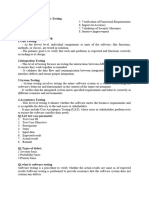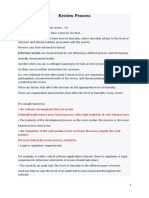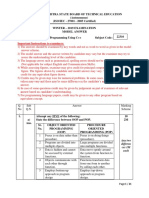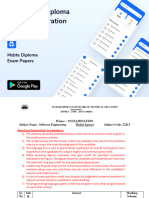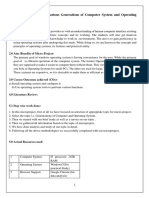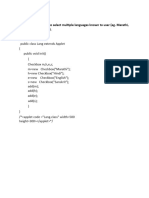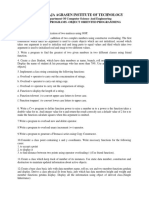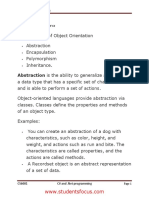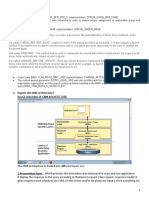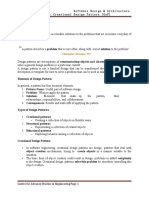Unit05 Ste (22518)
Unit05 Ste (22518)
Uploaded by
Vikrant KadamCopyright:
Available Formats
Unit05 Ste (22518)
Unit05 Ste (22518)
Uploaded by
Vikrant KadamOriginal Title
Copyright
Available Formats
Share this document
Did you find this document useful?
Is this content inappropriate?
Copyright:
Available Formats
Unit05 Ste (22518)
Unit05 Ste (22518)
Uploaded by
Vikrant KadamCopyright:
Available Formats
UNIT 05.
TESTING TOOLS AND MEASUREMENT
Manual Testing
Definition:
Manual testing is the process of testing software manually to identify defects without
using any automated tools.
Testers execute test cases, analyze results, and document issues to ensure the software
functions as expected.
Human Observation: It relies on human intuition and observation, which can sometimes
uncover subtle issues that automated tests might miss.
Flexible Approach: Manual testing allows testers to adapt quickly, explore different
scenarios, and test cases as needed.
Real-World Examples
1. Mobile App Usability Testing: When testing the user experience of a mobile app, manual
testers assess the design, usability, and user flow to ensure it’s intuitive and user-friendly.
For example, testers check if buttons, menus, and navigation elements work smoothly
and as expected.
2. Website Cross-Browser Testing: A tester manually checks a website on different
browsers and devices to ensure it displays correctly. For example, verifying that a
website's layout, fonts, and images appear as intended on both Chrome and Safari.
Advantages of Manual Testing
1. Human Insight: Testers can detect and explore unexpected behaviors, usability issues, or
other defects that automated tests may overlook.
2. Flexibility: Manual testing allows for quick adjustments in test cases, making it suitable
for exploratory or ad-hoc testing where the testing scope can change rapidly.
3. Cost-Effective for Small Projects: For small or short-term projects, manual testing can be
more cost-effective than investing in automation tools.
4. Immediate Feedback: Manual testing provides immediate feedback on functionality,
especially in the early stages, which helps in early detection of defects.
Diploma Helper. Feel free to DM us at . 8698079745
UNIT 05. TESTING TOOLS AND MEASUREMENT
Limitation / Disadvantages of manual testing
1. Time-Consuming:
Manual testing requires more time, especially for repetitive tests, making it slower than
automated testing.
2. Human Error:
Since manual testing depends on human efforts, it’s prone to errors, especially during
lengthy or complex test cases.
3. Limited Coverage:
It’s challenging to cover all possible test cases manually, which can leave certain areas of the
application untested.
4. Less Consistency:
Results may vary each time due to different testers, fatigue, or minor variations in testing
methods.
5. Not Suitable for Large-Scale Testing:
Manual testing is inefficient for projects requiring extensive testing, such as performance or
load testing.
6. Cannot Run on Multiple Platforms Simultaneously:
Testing across different environments (like browsers or OS) is hard to manage manually and
often requires more resources.
7. Lack of Reusability:
Test cases created manually lack reusability; they must be recreated or re-executed each
time.
8. Difficult to Track Test Results:
Tracking progress and maintaining detailed records is harder in manual testing compared to
automated testing tools.
Diploma Helper. Feel free to DM us at . 8698079745
UNIT 05. TESTING TOOLS AND MEASUREMENT
Automation Testing Tool
Definition:
Automation testing tools are software applications used to automate the process of
executing test cases, comparing results, and generating reports.
Efficiency: These tools eliminate repetitive manual work by running predefined scripts
and tests automatically.
Wide Usage: They are widely used in industries for tasks like regression testing,
performance testing, and load testing.
Real-World Examples
1. Selenium: A popular open-source automation testing tool used for web application
testing across multiple browsers and platforms. For example, testing the login
functionality of a banking website across Chrome and Firefox.
2. JMeter: An automation tool used for performance and load testing. For instance, testing
how an e-commerce website handles 1,000 users shopping simultaneously.
Disadvantages of Automation Testing Tools
1. High Initial Setup Cost: Setting up automation tools, including purchasing licenses and
training testers, can be expensive.
2. Limited to Predefined Tests: Automation tools cannot handle unexpected changes or ad-
hoc testing effectively, as they follow predefined scripts.
3. Requires Skilled Resources: Testers need to have technical skills to write and maintain
automated test scripts, which can be challenging for beginners.
4. Not Suitable for UI or Usability Testing: Automation tools cannot judge user experience,
design quality, or other aspects that require human observation.
Diploma Helper. Feel free to DM us at . 8698079745
UNIT 05. TESTING TOOLS AND MEASUREMENT
Advantages / Need for Automation Testing Tools
1. Time Efficiency:
Automation testing tools significantly reduce the time required to execute tests, especially
for repetitive and lengthy test cases. Automated tests can run much faster than manual tests,
allowing testers to focus on complex scenarios.
2. Improved Accuracy:
Automation tools reduce the likelihood of human error in testing. By following the same
steps every time, they ensure consistent results, which improves accuracy and reliability in
test execution.
3. Higher Test Coverage:
Automation allows for a wider scope of testing, enabling the execution of multiple test cases
across various environments, configurations, and data sets. This broadens test coverage and
helps identify more defects.
4. Reusability of Test Cases:
Automated test scripts can be reused across different projects or testing phases, saving time
and effort in the long run. This is especially useful for regression testing, where the same
tests are run repeatedly.
5. Supports Continuous Integration and Deployment:
Automation testing tools are essential for CI/CD processes, where code is frequently
integrated and deployed. Automated tests can be run with each build, ensuring new code
does not introduce defects.
6. Cost-Effective in the Long Term:
Although the initial setup of automation may be costly, it becomes cost-effective over time as
it reduces manual effort, increases productivity, and enables faster release cycles.
7. Performance and Load Testing:
Automation tools are critical for performance and load testing, where the application’s
response to a large number of users or data is measured. These tests are difficult and time-
consuming to execute manually.
8. Immediate Feedback for Developers:
Automated testing tools provide quick feedback to developers, allowing them to identify and
resolve defects early in the development cycle. This improves software quality and reduces
the cost of fixing bugs later.
Diploma Helper. Feel free to DM us at . 8698079745
UNIT 05. TESTING TOOLS AND MEASUREMENT
Enlist any 6 testing tools
(6 testing tool che name learn karun theva and safe side description kara if asked)
1. Selenium
o An open-source tool for automating web applications across various browsers.
2. JUnit
o A widely used framework for Java programming language, specifically designed for
unit testing.
3. TestComplete
o A commercial tool that provides automated UI testing for desktop, mobile, and web
applications.
4. QTP (QuickTest Professional)
o An automated functional testing tool for web and desktop applications, now called
UFT (Unified Functional Testing).
5. LoadRunner
o A performance testing tool that helps to test the performance and load capacity of
applications.
6. Appium
o A mobile testing tool for automated testing of Android and iOS applications.
7. Postman
o A tool for testing APIs by making HTTP requests and validating responses.
8. JMeter
o An open-source tool for performance and load testing of web applications.
9. Cucumber
o A tool that supports Behavior Driven Development (BDD) for testing web
applications by writing tests in natural language.
10. Ranorex
An automation tool for UI testing, suitable for web, desktop, and mobile applications.
Diploma Helper. Feel free to DM us at . 8698079745
UNIT 05. TESTING TOOLS AND MEASUREMENT
Difference between Mannual testing and automated tesing
Diploma Helper. Feel free to DM us at . 8698079745
UNIT 05. TESTING TOOLS AND MEASUREMENT
Advantages and Disadvantages of Using Testing Tools
1. Definition and Explanation
Testing Tools are software applications designed to support testing activities, whether
it's for automation, performance analysis, or defect tracking.
These tools help increase efficiency, improve test coverage, and ensure better quality
software by streamlining repetitive testing tasks.
2. Advantages of Using Software Testing Tools
1. Increased Efficiency
o Tools automate repetitive tasks, saving time and effort.
2. Improved Accuracy
o Automated tests reduce human errors in testing processes.
3. Consistency
o Tools execute tests consistently, ensuring uniformity.
4. Reusability
o Test scripts can be reused for multiple test cycles.
5. Faster Testing
o Tools can execute multiple tests simultaneously, speeding up the process.
6. Comprehensive Reporting
o Many tools provide detailed reports for better analysis.
7. Scalability
o Tools handle large volumes of data and users during performance testing.
8. Cross-Platform Testing
o Some tools support testing on different platforms and devices.
Diploma Helper. Feel free to DM us at . 8698079745
UNIT 05. TESTING TOOLS AND MEASUREMENT
3. Disadvantages of Using Software Testing Tools
1. High Cost
o Some tools require expensive licenses and maintenance.
2. Complex Setup
o Installation and configuration can be time-consuming.
3. Learning Curve
o Tools often require specialized training to use effectively.
4. Limited Scope
o Not all testing scenarios can be automated.
5. Dependency on Tools
o Over-reliance on tools may reduce manual testing skills.
6. Initial Investment
o Developing and maintaining automation scripts can take significant effort
initially.
7. Tool Limitations
o Some tools might not support certain technologies or frameworks.
8. Frequent Updates
o Tools require updates to remain compatible with new software versions.
Diploma Helper. Feel free to DM us at . 8698079745
UNIT 05. TESTING TOOLS AND MEASUREMENT
Selecting a Testing Tool
1. Definition and Explanation
Selecting a Testing Tool involves evaluating and choosing the right tool that best fits the
testing needs, project requirements, and the application under test.
The right testing tool helps improve efficiency, accuracy, and coverage, and must align
with factors like the project’s budget, scope, timeline, and technology stack.
It's important to understand both the advantages and limitations of each tool to ensure
it supports the testing goals effectively.
2. Factors to Consider While Selecting a Testing Tool
Project Requirements:
o Is the tool needed for automation, functional testing, performance testing, or
security testing?
o Does the tool support the platforms, browsers, or operating systems that the
application uses?
Cost:
o Does the tool fit within the project’s budget? Some tools are free (open-source),
while others are commercial with licensing fees.
Ease of Use:
o Is the tool user-friendly? A tool with an easy-to-understand interface or an
intuitive workflow can reduce the learning curve.
Integration Capabilities:
o Does the tool integrate with other software tools, like bug-tracking systems,
CI/CD pipelines, or version control systems?
Support and Documentation:
o Does the tool have good community support or customer service? Availability of
resources like documentation, tutorials, or forums is essential.
Scalability:
o Can the tool handle large-scale testing needs as the application grows, especially
for performance or load testing?
Compatibility:
o Does the tool support the required technologies (e.g., web, mobile, desktop,
APIs) or specific frameworks used by the application?
Reporting and Analytics:
o Does the tool offer comprehensive reporting features that help in analyzing test
results, identifying defects, and tracking the progress?
Diploma Helper. Feel free to DM us at . 8698079745
UNIT 05. TESTING TOOLS AND MEASUREMENT
3. The following factors are important during tool selection:
(this is from model you can refer above or this as well)
Assessment of the organization’s maturity (e.g., readiness for change).
Identification of the areas within the organization where tool support will help to
improve testing processes.
Evaluation of tools against clear requirements and objective criteria.
Proof-of-concept to see whether the product works as desired and meets the
requirements and objectives defined for it.
Evaluation of the vendor (training, support and other commercial aspects) or open
source network of support.
Identifying and planning internal implementation (including coaching and mentoring for
those new to the use of the tool).
4. Real-Life Examples
Example 1: When selecting an automation tool for a web application, you might
consider Selenium for browser compatibility, TestComplete for its user-friendly interface,
or Cypress for modern web frameworks. Each of these tools has its strengths depending
on the testing needs.
Example 2: For performance testing, tools like JMeter or LoadRunner are commonly
evaluated. JMeter is suitable for open-source testing, whereas LoadRunner is often
preferred for enterprise-level testing.
Diploma Helper. Feel free to DM us at . 8698079745
UNIT 05. TESTING TOOLS AND MEASUREMENT
1. Static Testing Tools
Definition:
Static testing tools are used to evaluate software without executing the code. They analyze
the code, documentation, or design to identify defects early.
Examples:
SonarQube: Used for code quality analysis and identifying vulnerabilities.
Pylint: A Python source code analyzer.
Checkstyle: A tool for checking Java source code against coding standards.
Advantages:
1. Detects errors early in the development process.
2. Reduces the cost of fixing defects.
3. Improves code quality and compliance.
4. Does not require running the application.
Disadvantages:
1. Limited to identifying code-related issues.
2. Cannot detect runtime errors.
3. Requires skilled personnel for effective use.
4. May produce false positives or negatives.
2. Dynamic Testing Tools
Definition:
Dynamic testing tools are used to evaluate the software by executing the code to test its
runtime behavior and functionality.
Examples:
Selenium: Automates web application testing.
JMeter: Tests application performance under load.
Postman: Tests APIs by sending requests and validating responses.
Advantages:
1. Identifies runtime errors and issues.
2. Ensures functionality meets user requirements.
3. Can simulate real-world scenarios.
4. Supports performance and stress testing.
Diploma Helper. Feel free to DM us at . 8698079745
UNIT 05. TESTING TOOLS AND MEASUREMENT
Disadvantages:
1. Requires a functioning application for testing.
2. More time-consuming than static testing.
3. Higher cost due to tool licenses and setup.
4. Dependent on test environment configurations.
Key Difference:
Static Testing: Involves reviewing code or documents without execution.
Dynamic Testing: Involves executing the code to check functionality and
performance.
Differentiate between static and dynamic testing tools.
Diploma Helper. Feel free to DM us at . 8698079745
UNIT 05. TESTING TOOLS AND MEASUREMENT
Metrics and Measurement
1. Software Metrics
Definition:
Software metrics are quantitative measures used to evaluate various aspects of a software
project, such as quality, performance, productivity, and reliability.
These metrics provide insights for improving software processes, products, and project
management.
Purpose:
1. Help in assessing the progress and health of a software project.
2. Aid in decision-making, quality control, and process improvement.
Base Metrics
1. Definition:
Base metrics are the raw data collected during the software development and
testing processes. These are the foundation metrics upon which other calculations
and metrics are built.
2. Examples of Base Metrics:
Lines of Code (LOC)
o Measures the total number of lines of code written in the
software.
o Example: 5000 lines of code in a project.
Number of Test Cases
o The total count of test cases written for a project.
o Example: 120 test cases written for testing functionalities.
3. Advantages of Base Metrics:
Simplicity
o Easy to collect and understand without complex computations.
Foundation for Other Metrics
o Provides raw data needed to calculate more advanced metrics
like productivity or defect density.
Early Insights
o Gives an initial view of project size or testing efforts.
Consistency
Diploma Helper. Feel free to DM us at . 8698079745
UNIT 05. TESTING TOOLS AND MEASUREMENT
o Offers consistent data points for comparison across projects.
4. Disadvantages of Base Metrics:
Limited Insights
o By themselves, they do not provide meaningful information.
Context-Dependent
o Misleading without proper interpretation or additional metrics.
No Quality Indication
o Quantity-based and may not reflect software quality.
Does Not Account for Complexity
o Ignores the complexity of tasks or the efficiency of processes.
Calculated Metrics
1. Definition:
Calculated metrics are derived by combining base metrics using formulas or calculations
to provide meaningful insights into the software process or product.
2. Examples of Calculated Metrics:
Defect Density
o Formula:
o Example: If there are 50 defects in 10,000 lines of code, the defect
density is 0.005 defects per LOC.
Test Case Effectiveness
o Formula:
o Example: If 40 out of 50 defects are found by test cases, the
effectiveness is 80%.
Diploma Helper. Feel free to DM us at . 8698079745
UNIT 05. TESTING TOOLS AND MEASUREMENT
3. Advantages of Calculated Metrics:
Meaningful Insights
o Provides actionable data for quality control and decision-
making.
Performance Tracking
o Helps track and improve team and project performance over
time.
Risk Assessment
o Identifies high-risk areas based on defect trends or performance
issues.
Customizable
o Can be tailored to specific project needs or goals.
4. Disadvantages of Calculated Metrics:
Dependent on Base Metrics
o Errors in base metrics can result in inaccurate calculated metrics.
Complexity
o Requires knowledge of formulas and proper interpretation.
Over-Reliance
o Overemphasis on metrics can lead to ignoring qualitative
aspects like user satisfaction.
Context Sensitivity
o Misinterpretation possible without understanding project
context.
Diploma Helper. Feel free to DM us at . 8698079745
UNIT 05. TESTING TOOLS AND MEASUREMENT
Product Metrics
1. Definition:
Product metrics are quantitative measures that evaluate the characteristics of a
software product, such as its functionality, reliability, maintainability, and
performance.
2. Examples of Product Metrics:
Code Complexity
o Measures the complexity of code using metrics like Cyclomatic
Complexity.
o Example: A function has a complexity score of 12.
Defect Density
o Measures the number of defects per unit of software size (e.g.,
per 1,000 lines of code).
o Example: 0.8 defects per 1,000 lines of code.
3. Advantages of Product Metrics:
Quality Assessment
o Helps assess the overall quality of the software product.
Improves Reliability
o Identifies areas prone to defects, leading to better testing and
error prevention.
Maintainability Insights
o Provides metrics to estimate ease of future maintenance.
Performance Tracking
o Tracks improvements in product performance over time.
4. Disadvantages of Product Metrics:
Code-Only Focus
o Often limited to measurable code aspects, ignoring user
experience.
Effort Intensive
o Requires significant effort to collect and analyze data accurately.
Misleading Data
o Incorrect interpretation can lead to flawed decisions.
Dependency on Tools
Diploma Helper. Feel free to DM us at . 8698079745
UNIT 05. TESTING TOOLS AND MEASUREMENT
o Often requires specialized tools, increasing costs.
Process Metrics
1. Definition:
Process metrics are quantitative measures that evaluate the efficiency and effectiveness
of the processes used during software development and maintenance.
2. Examples of Process Metrics:
Defect Removal Efficiency (DRE)
o Formula:
o Example: If 80 defects are removed during development and
100 are detected in total, the DRE is 80%.
Effort Variance
o Measures the difference between estimated and actual effort.
Example: Estimated effort = 200 hours, actual effort =
220 hours, variance = +10%.
3. Advantages of Process Metrics:
Improves Efficiency
o Identifies bottlenecks in the development process for
improvement.
Risk Management
o Helps detect and mitigate risks early in the process.
Process Optimization
o Guides teams to refine workflows and increase productivity.
Predictive Analysis
o Assists in forecasting timelines and resource requirements.
4. Disadvantages of Process Metrics:
Data Collection Challenges
o Accurate data collection can be time-consuming and complex.
Context Dependency
o Results may vary significantly based on project or team context.
Overemphasis on Metrics
o Excess focus on metrics may lead to ignoring qualitative aspects
of processes.
Tool Dependency
o Requires appropriate tools and techniques, which might not be
readily available.
Diploma Helper. Feel free to DM us at . 8698079745
UNIT 05. TESTING TOOLS AND MEASUREMENT
Comparison Table
Aspect Product Metrics Process Metrics
Definition Measures product characteristics Measures process effectiveness
Examples Code Complexity, Defect Density DRE, Effort Variance
Advantages Quality assessment, maintainability Efficiency, risk management
Disadvantages Focus on code, costly tools Data collection challenges
Comparison Table
Aspect Base Metrics Calculated Metrics
Definition Raw data collected directly Metrics derived from base metrics
Defect Density, Test Case
Examples Lines of Code, Test Cases
Effectiveness
Insightful, customizable,
Advantages Simple, foundational, consistent
actionable
Disadvantages Limited insights, lacks quality Complex, context-sensitive
Diploma Helper. Feel free to DM us at . 8698079745
UNIT 05. TESTING TOOLS AND MEASUREMENT
2. Measurement
Definition:
Measurement is the process of collecting and analyzing data to quantify attributes of
software or its process.
o Example: Measuring the execution time of test cases to assess performance.
Difference:
o Measurement: Focuses on collecting raw data.
o Metrics: Involves analyzing and deriving insights from the measured data.
Need for Software Measurement
1. Quality Assurance
o To ensure the software meets predefined quality standards.
o Example: Measuring defect rates to monitor quality.
2. Performance Tracking
o Helps track the efficiency of the development and testing processes.
3. Project Management
o Metrics assist in resource allocation, timeline management, and budget estimation.
4. Process Improvement
o Identifies weaknesses in processes and helps improve them over time.
5. Risk Assessment
o Predicts potential risks based on historical data and trends.
6. Productivity Measurement
o Tracks team productivity by analyzing metrics like test execution rates.
7. Decision Support
o Provides data-driven insights to make informed decisions during the software
lifecycle.
8. Customer Satisfaction
o Ensures the delivered software aligns with user requirements and expectations.
Diploma Helper. Feel free to DM us at . 8698079745
UNIT 05. TESTING TOOLS AND MEASUREMENT
Object-Oriented Matrix in Testing
Definition:
An Object-Oriented (OO) Matrix in testing is a systematic approach to evaluate the quality of
object-oriented features in software, such as classes, objects, inheritance, polymorphism, and
encapsulation. It ensures that all object-oriented elements and their interactions are adequately
tested.
Purpose:
1. Ensures thorough testing of OO components and their relationships.
2. Helps measure the effectiveness of testing strategies for OO systems.
3. Facilitates identifying defects in OO features like inheritance misuse or polymorphism
errors.
Key Components of the Object-Oriented Matrix
1. Class Testing:
o Focuses on verifying the functionality and behavior of individual classes.
o Example: Testing methods within a class to ensure proper input-output behavior.
2. Inheritance Testing:
o Verifies that subclasses inherit properties and methods correctly from parent
classes.
o Example: Ensuring a child class correctly overrides a parent class method.
3. Polymorphism Testing:
o Checks if different objects can be used interchangeably based on a shared
interface.
o Example: Ensuring that calling the same method on different objects yields
expected results.
4. Encapsulation Testing:
o Validates that data hiding is implemented correctly through access control (e.g.,
private, protected).
o Example: Ensuring private variables are not directly accessible outside the class.
5. Object Interaction:
o Tests interactions between objects to ensure correct communication and data
exchange.
Diploma Helper. Feel free to DM us at . 8698079745
UNIT 05. TESTING TOOLS AND MEASUREMENT
Advantages of Object-Oriented Matrix
1. Comprehensive Coverage:
o Ensures all OO elements and relationships are tested thoroughly.
2. Improved Debugging:
o Helps identify issues specific to OO features, like inheritance or polymorphism
errors.
3. Risk Reduction:
o Reduces the risk of defects in complex OO interactions.
4. Enhanced Quality:
o Improves the reliability and robustness of OO software.
Disadvantages of Object-Oriented Matrix
1. Complex Setup:
o Requires detailed planning and mapping for large systems.
2. High Maintenance:
o As software evolves, updating the matrix can be time-consuming.
3. Resource Intensive:
o Demands expertise and additional effort to design and implement.
4. Tool Dependency:
o May require specific tools to manage and track the matrix effectively.
Example Structure of an Object-Oriented Matrix
Feature Test Scenario Test Case Expected Result Status
Correct output
Class Validate class methods Input parameter testing Passed
generated
Subclass overrides Overridden method Executes overridden
Inheritance Passed
parent execution method
Expected method
Object substitution Call method on interface Failed
Polymorphism behavior
Test private variable
Encapsulation Direct access attempt Access denied Passed
access
Diploma Helper. Feel free to DM us at . 8698079745
UNIT 05. TESTING TOOLS AND MEASUREMENT
Winter 2019
1. State any four advantages of using tools. (2marks)
2. State any eight limitations of manual testing (4marks)
3. Describe object-oriented metrics in testing. (4marks)
4. Elaborate the term metrics and measurement and write the need of software measurement.
(6marks)
Summer 2022
1. Enlist any four testing tools. (2marks)
2. Describe different factors for selecting a testing tool. (4marks)
3. State any eight limitations of Manual Testing (4marks)
4. Describe need for Automated Testing tools. (4marks)
5. Elaborate the concept of Software Metrics? Describe Base Metrics and calculated matrics with
suitable example. (6marks)
Winter 2022
1. State the need of automated testing tools. (2marks)
2. State the limitations of manual testing. (4marks)
3. Enlist the factors considered for selecting a testing tool for test automation.. (4marks)
4. State the advantages and disadvantages of using tools. (4marks)
Summer 2023
1. State any two differences between manual and automated testing. (2marks)
2. Describe any four limitations of manual testing. (4marks)
3. Differentiate between static and dynamic testing tools. (any four points). (4marks)
4. Describe the criterias to select testing tools. (4marks)
5. Define metrics and measurements. Describe three types of metrics. (6marks)
Winter 2023
1. Enlist any four software testing tools. (2marks)
2. Describe any four factors for selecting a testing tools. (4marks)
3. State & explain any four benefits of automation in testing. (4marks)
4. State any four limitations of manual testing. (4marks)
Summer 2024
1. State the need of automated testing tool. (Any two). (2marks)
2. Differentiate between static and dynamic testing tools. (any four points). (4marks)
3. Give any four differences between manual and automated testing. (Any 4 points). (4marks)
4. Describe any four limitations of manual testing. (4marks)
5. How to select a testing tool? Explain in detail.(6marks)
Diploma Helper. Feel free to DM us at . 8698079745
You might also like
- CS2103/CS2103T SummaryDocument6 pagesCS2103/CS2103T SummaryKhor Shi-Jie100% (2)
- STE UNIT-5 NotesDocument14 pagesSTE UNIT-5 Notessachingunjal401No ratings yet
- Css Unit-4 NotesDocument20 pagesCss Unit-4 NotesoooNo ratings yet
- CSS SolutionDocument97 pagesCSS Solutionjadhavayush590No ratings yet
- Msbte QB Ste (22518)Document9 pagesMsbte QB Ste (22518)Jay BhakharNo ratings yet
- Ajp CH1 Solved QBDocument16 pagesAjp CH1 Solved QByashkedare1742006No ratings yet
- STE UNIT-1 NotesDocument14 pagesSTE UNIT-1 Notesspidermakdi5324No ratings yet
- UNIT-I Basics of JavaScript ProgrammingDocument43 pagesUNIT-I Basics of JavaScript Programmingrutpatil0347No ratings yet
- Unit 2:chapter 2: Software Testing StrategiesDocument37 pagesUnit 2:chapter 2: Software Testing StrategiesRohit KoliNo ratings yet
- Informal Review in Software TestingDocument42 pagesInformal Review in Software TestingElena AlinaNo ratings yet
- Principals of Database (22321) : Prepared by Ms. Khan Sameera I/C If Hod M.H.Saboo Siddik PolytechnicDocument56 pagesPrincipals of Database (22321) : Prepared by Ms. Khan Sameera I/C If Hod M.H.Saboo Siddik PolytechnicPRABHAKAR MORENo ratings yet
- Practical No.1 Q1. Design An Applet/application To Demonstrate The Use of Radio Button and CheckboxDocument22 pagesPractical No.1 Q1. Design An Applet/application To Demonstrate The Use of Radio Button and Checkboxxapalek559No ratings yet
- STE - Unit V (PIP)Document9 pagesSTE - Unit V (PIP)divya lokhandeNo ratings yet
- Oop Winter 2019 (C++)Document21 pagesOop Winter 2019 (C++)Aditya BorleNo ratings yet
- STE ProjectDocument35 pagesSTE Projectabhisawant3101No ratings yet
- Software Eng NotesDocument23 pagesSoftware Eng Notessudarshan badwarNo ratings yet
- Class Notes HTML CSS Chapter5Document10 pagesClass Notes HTML CSS Chapter5Syed ShoaibNo ratings yet
- DTE MPDocument17 pagesDTE MPHarsh tandelNo ratings yet
- The Marksheet Generation System Aims at DevelopingDocument2 pagesThe Marksheet Generation System Aims at DevelopingSabaNo ratings yet
- Chapter 6 Menu Navigation & Web Page ProtectionDocument32 pagesChapter 6 Menu Navigation & Web Page ProtectionPriya MaliNo ratings yet
- STE MicroprojectDocument16 pagesSTE MicroprojectShreelesh PawarNo ratings yet
- Mad EpaDocument115 pagesMad Epa514 Vaibhavi PawarNo ratings yet
- CSS Micro ProjectDocument19 pagesCSS Micro Projectethicalninja70% (1)
- Test Plan IdentifierDocument4 pagesTest Plan Identifierragimi3592No ratings yet
- Software Testing Important Question Bank.Document6 pagesSoftware Testing Important Question Bank.Manoj KavediaNo ratings yet
- AJP MCQ Unit I PracticeDocument44 pagesAJP MCQ Unit I PracticeSmit ShahNo ratings yet
- OSY Board Questions With AnswersDocument51 pagesOSY Board Questions With AnswersHemil ShahNo ratings yet
- CGR Report1 (3), MAINDocument18 pagesCGR Report1 (3), MAINDhiraj Chaudhari CO-137No ratings yet
- UNIT 4 ACN UpdatedDocument68 pagesUNIT 4 ACN UpdatedagasyabutoliaNo ratings yet
- Types of OsDocument12 pagesTypes of OsRamaseshu MachepalliNo ratings yet
- Practical No. 5: Aim: Prepare Test Plan For An Identified Mobile Application. TheoryDocument7 pagesPractical No. 5: Aim: Prepare Test Plan For An Identified Mobile Application. TheoryPurval Dhumale0% (1)
- Unit IiiDocument19 pagesUnit Iiisawantsankya4197No ratings yet
- Assignment 11: Prepare Defect Report After Executing Test Cases For Withdrawn of Amount For ATM MachineDocument1 pageAssignment 11: Prepare Defect Report After Executing Test Cases For Withdrawn of Amount For ATM MachineAbrar NadafNo ratings yet
- Operating System MicroprojectDocument6 pagesOperating System MicroprojectkhenatavishkarNo ratings yet
- Advance Java Practical ListDocument58 pagesAdvance Java Practical ListViral Parmar100% (1)
- CSS Pract 11-16 - MergedDocument31 pagesCSS Pract 11-16 - Mergedrathodharshalr1905No ratings yet
- UNIT-II The Art of Assembly Language ProgrammingDocument9 pagesUNIT-II The Art of Assembly Language Programminggareprathmesh0No ratings yet
- Advanced Java Chapter 2Document8 pagesAdvanced Java Chapter 2SabonaNo ratings yet
- Osy NotesDocument13 pagesOsy Notespankaj waghmareNo ratings yet
- 22 Karan Rathod AJP Practical 2Document3 pages22 Karan Rathod AJP Practical 217 KAUSTUBHI SHIMPINo ratings yet
- CSS Summer 22Document32 pagesCSS Summer 22706:Pranav BhingareNo ratings yet
- Program-1.2 //develop A Program To Select Multiple Languages Known To User (Eg. Marathi, Hindi, English, Sanskrit)Document2 pagesProgram-1.2 //develop A Program To Select Multiple Languages Known To User (Eg. Marathi, Hindi, English, Sanskrit)rohitchavan2345No ratings yet
- Event Handling and GUI ProgrammingDocument21 pagesEvent Handling and GUI ProgrammingVenneti Sri sai vedanthNo ratings yet
- Applet Notes PDFDocument8 pagesApplet Notes PDFrajuvathariNo ratings yet
- Project Report - FertilizersDocument32 pagesProject Report - FertilizersbhanuprasadvishwakarNo ratings yet
- Osy Lecture 3.2 Notes - Msbte Next IconDocument8 pagesOsy Lecture 3.2 Notes - Msbte Next IconRupesh BavgeNo ratings yet
- Project Synopsis College Notes Management System: Presented ByDocument8 pagesProject Synopsis College Notes Management System: Presented ByDipesh GuptaNo ratings yet
- UNIT-VI Notes Adavance JavaDocument22 pagesUNIT-VI Notes Adavance JavaRupesh BavgeNo ratings yet
- Oop - Micro - (1136214941)Document14 pagesOop - Micro - (1136214941)Shivali DhumalNo ratings yet
- ServletDocument233 pagesServletYashpal VaghelaNo ratings yet
- CSS Summer 23Document38 pagesCSS Summer 23706:Pranav BhingareNo ratings yet
- Write A Program To Create A Session Cookie and Display Content of CookieDocument2 pagesWrite A Program To Create A Session Cookie and Display Content of CookiesakshiNo ratings yet
- S23 Model SolutionDocument25 pagesS23 Model Solutiontanupandav333No ratings yet
- Test Plan For OpenCartDocument14 pagesTest Plan For OpenCartkalyani05022015100% (1)
- Airline Management System Project.Document11 pagesAirline Management System Project.R JadhavNo ratings yet
- CSS Chapter 3 NotesDocument13 pagesCSS Chapter 3 Notespathanfarhankhan712No ratings yet
- Question Bank CSSDocument11 pagesQuestion Bank CSSSanika mandalwarNo ratings yet
- AJP Micro ProjectDocument35 pagesAJP Micro Projectrautkalpana192No ratings yet
- Exercise 1. Write A Program To Change The Background Colour of Applet When User Performs Events Using MauseDocument2 pagesExercise 1. Write A Program To Change The Background Colour of Applet When User Performs Events Using MauseGanesh EkambeNo ratings yet
- UNIT-II Notes Java ScriptDocument30 pagesUNIT-II Notes Java ScriptkrishnaNo ratings yet
- Testing Tools and Measurements: (Any 4 Appropriate Limitations of Manual Testing - 4marks 1 Mark Each)Document9 pagesTesting Tools and Measurements: (Any 4 Appropriate Limitations of Manual Testing - 4marks 1 Mark Each)Jayesh DeshmukhNo ratings yet
- Book 5Document2 pagesBook 5Vikrant KadamNo ratings yet
- Css ReportDocument9 pagesCss ReportVikrant KadamNo ratings yet
- AJP P-10 For Manual OutputsDocument2 pagesAJP P-10 For Manual OutputsVikrant KadamNo ratings yet
- Tans 8Document1 pageTans 8Vikrant KadamNo ratings yet
- Day 3 Java Codesy Center Notes NewDocument5 pagesDay 3 Java Codesy Center Notes NewVikrant KadamNo ratings yet
- p03b TheoryQuestionDocument3 pagesp03b TheoryQuestionMalvin ChitswamatomboNo ratings yet
- JP Questions All UnitsDocument5 pagesJP Questions All Unitsssrkm guptaNo ratings yet
- Sudipta PaulDocument10 pagesSudipta PaulAnonymousNo ratings yet
- Bapis For DMSDocument51 pagesBapis For DMSAdrian MarchisNo ratings yet
- Chapter 10 Thinking in ObjectsDocument67 pagesChapter 10 Thinking in ObjectsBhavik DaveNo ratings yet
- My Java NotesDocument52 pagesMy Java NotesNikhil BhardwajNo ratings yet
- ClassPresentationSD224848LPushingRevittotheNextLevelAnIntrotoRevitPluginswithCJeremyGraham PDFDocument38 pagesClassPresentationSD224848LPushingRevittotheNextLevelAnIntrotoRevitPluginswithCJeremyGraham PDFTruels WissnethNo ratings yet
- Latihan Soal Revisi - 1Document93 pagesLatihan Soal Revisi - 1Anugrah Pratama75% (4)
- Custom COPY Function Using AMDP - SAP BlogsDocument9 pagesCustom COPY Function Using AMDP - SAP BlogsBo ZhangNo ratings yet
- Introduction To Java ProgrammingDocument107 pagesIntroduction To Java ProgrammingKUSHAL S YADAVNo ratings yet
- Personality Prediction System Through CV AnalysisDocument38 pagesPersonality Prediction System Through CV AnalysisVVCET - CSE67% (12)
- Lab QBank 2018Document4 pagesLab QBank 2018Varsha GowdaNo ratings yet
- CSP 44 Block 03Document68 pagesCSP 44 Block 03BiswamitNo ratings yet
- RRS Software Design ReportDocument25 pagesRRS Software Design ReportAakansh ShrivastavaNo ratings yet
- List of Programs OopsDocument3 pagesList of Programs OopsDivyansh JunejaNo ratings yet
- Mca PDFDocument34 pagesMca PDFAyush KumarNo ratings yet
- OOP - I GTU Study Material Presentations Unit-1 07022022102854PMDocument59 pagesOOP - I GTU Study Material Presentations Unit-1 07022022102854PMPrdella LtdNo ratings yet
- Spring Class Notes by Raghu SirDocument156 pagesSpring Class Notes by Raghu Sirprasad p100% (2)
- Advanced Topics&Reference GuideDocument202 pagesAdvanced Topics&Reference GuideRoberto Hernandez Ameca100% (1)
- Java Questions and AnswersDocument4 pagesJava Questions and AnswersVikas PallewarNo ratings yet
- SCJPDocument55 pagesSCJPKuttyNo ratings yet
- 2013 RegulationDocument64 pages2013 RegulationpradeepaNo ratings yet
- Self Test QuestionsDocument46 pagesSelf Test QuestionsSam Djjs NileshNo ratings yet
- Guidelines For CSB PGT Computer ScienceDocument11 pagesGuidelines For CSB PGT Computer Sciencebulbtommy100% (1)
- M1 - 1 OOP MODULE 1 Approaches To Software DesignDocument37 pagesM1 - 1 OOP MODULE 1 Approaches To Software Designflemin23b25No ratings yet
- Sap-Crm-Technical Interview QuestionsDocument25 pagesSap-Crm-Technical Interview QuestionsJaitheradeviNo ratings yet
- Friend Function and Friend Classes in C++Document17 pagesFriend Function and Friend Classes in C++Natali PuriNo ratings yet
- HCQL HibernateDocument4 pagesHCQL HibernateVeera phanindraNo ratings yet
- Lab 11 (Creational Design Pattern (GoF) )Document5 pagesLab 11 (Creational Design Pattern (GoF) )Wasie UrrahmanNo ratings yet




